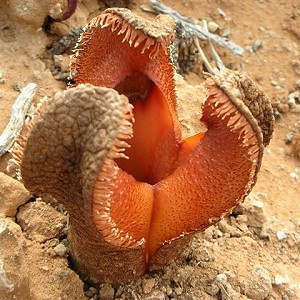
|
|
Hydnora (Hydnora
africana)
|
Hydnora - Hydnora africana
Hydnora africana is an achlorophyllous plant native to southern Africa that is parasitic on the roots of members of the Euphorbiaceae
family. The plant grows underground, except for a fleshy flower that emerges above ground and emits an odor of feces to attract its natural
pollinators, dung beetles, and carrion beetles. The flowers act as traps for a brief period retaining the beetles that
enter, then releasing them when the flower is fully opened.
Hydnora africana. Hydnora occurs at a few localities in southern and western Namibia and South Africa's northern
Cape, growing on the roots of Euphorbia. The parasite attaches itself to Euphorbia roots 5-15cm below
ground, but will not harm the host. It is rarely encountered, as it exposes only its rather
bizarre-looking dark red flower five to eight centimetres above the
ground, often amid the host shrub.
The parasytic plant was first discovered by botanists near
Calvinia, collected and documented in 1774 by Carl Peter Thunberg, the Swedish botanist known as the father of South African
botany. Thunberg also established that it is edible, although he thought it to be a
fungus, naming it Hydnus, the Greek word for fungus-like.
Before the flower has
opened, it resembles a fungus rather like an elongated truffle, for which it could easily be
mistaken, hence its name Hydnora (after the fungal genus Hydnum).
The flower takes over a year to develop, and is as hard as wood. ‘he flower itself standing
4-7cm tall. It is bright red, fleshy and hollow inside, its four thick
tulip-shaped petals joined at the top. To attract pollinators such as carrion
beetles, it emits the unpleasant rotting-flesh odour. As the plant is often hidden within the host
bush, it is quite difficult to find, but is betrayed by its smell.
After pollination a fleshy fruit develops over two
years. The fruit is edible to humans, birds and small mammals. Each fruit can contain over 20 000
seeds. Unperturbed, jackal and baboon eat the fruit that develops from the
flowers, as do the Khoi-San people, from which it derives its local name: Bushman's
salad.
The natives dig it up to roast and eat; it then tastes like the flesh of a
cocoa-nut.
The local names Jakkalskos and Bobbejaankos was ginen to Hydnora because
itís a favoured food of jackals and baboons.
The fruit is extremely astringent and has been used for tanning and preserving fishing
nets. Diarrhoea, dysentery, kidney and bladder complaints are all treated with infusions and decoctions of Hydnora
africana. Infusions used as a face wash also treat acne. Diarrhoea,
dysentery, kidney and bladder complaints are all treated with infusions and decoctions of Hydnora
africana. Infusions used as a face wash also treat acne.
Source:
http://en.wikipedia.org/wiki/Hydnora_africana
http://www.travelafricamag.com/content/view/703/72/
http://www.slowfoodcapetown.co.za/
news/november04/endangered.htm
http://www.plantzafrica.com/planthij/hydnorafric.htm
